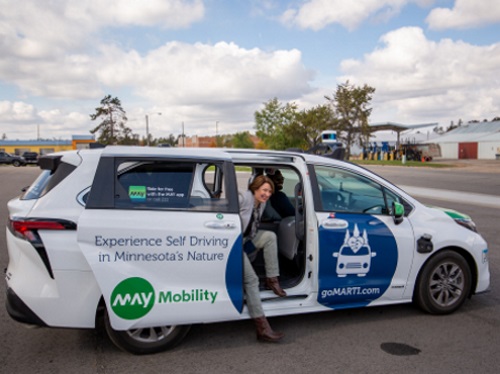Autonomous vehicle developer May Mobility and transit technology provider Via recently launched the first national test of American Disability Act-compliant autonomous vehicles or AVs for rural transit service with the help of the Minnesota Department of Transportation.
[Above photo by May Mobility]
This AV project – which uses Toyota Sienna Autono-MaaS minivans – aims to demonstrate that AVs reach their greatest societal impact when used for public transportation. The deployment will allow anyone to book a free, on-demand, shared ride from an AV while tracking their ability to handle rural terrains as well as diverse and sometimes harsh weather conditions.

The 18-month project – called “goMARTI” – involves not just Minnesota DOT but the PLUM Catalyst, 211 and Mobility Mania, among others.
“We’re passionate about making transportation better for everyone, and providing innovative, accessible transportation solutions to rural communities is a key next step in that journey,” said Edwin Olson, CEO for May Mobility, in a statement.
“[This project] advances our shared belief that AVs are most impactful when they are accessible, shared, and complementary to a community’s public transit system,” added Israel Duanis, head of AVs at Via. “We are committed to supporting rural connectivity for riders of all needs [and] believe [this project] will pioneer how autonomous, innovative mobility can transform the way small communities move.”
[Editor’s note: In October 2021, the American Association of State Highway and Transportation Officials published a policy paper outlining the ten key policy principles needed for connected and automated vehicles or CAVs – a paper intended to be a “living document,” reviewed and updated every year to reflect changes in technology and policy.]
Powered by Via’s artificial intelligence or AI-based booking and routing algorithms, on-demand rides are available to anyone through the Via app – available on iOS and Android – that matches riders headed in the same direction into one vehicle to create efficient, flexible shared trips.
The test – conducted in Grand Rapids, MN – involves over 70 pick-up and drop-off locations based on popular travel patterns and community input, which helped shape the service zone, hours of operation and other considerations. Riders without smartphones can also book by calling 211.
While rides are open to all, they seek to serve those without a private car or who have mobility challenges — with the aim of using technology to help everyone achieve an independent lifestyle supported by convenient travel, regardless of income or ability.
This project will expand mobility access for the Grand Rapids community by complementing the town’s existing fixed-route bus lines and will cover nearly 17 square miles. The service will also provide coverage on weekday nights and weekends when other options are not available.
The Minnesota DOT has been involved with several AV test projects over the last several years. In August, the agency helped launch a free, low-speed, driverless, all-electric, multi-passenger shuttle service called “Bear Tracks” for the city of White Bear Lake.
It also made two low-speed, driverless, electric, multi-passenger shuttles called the Med City Mover available for free public rides in downtown Rochester back in October 2021.
 Nation
Nation
Registration Open for 2026 AASHTO Washington Briefing
December 12, 2025 Nation
Nation

